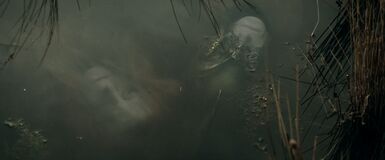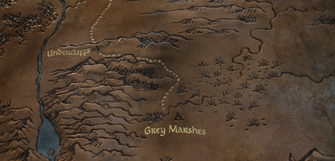- "Dreary and wearisome. Cold, clammy winter still held sway in this forsaken country. The only green was the scum of livid weed on the dark greasy surfaces of the sullen waters. Dead grasses and rotting reeds loomed up in the mists like ragged shadows of long forgotten summers."
- —The Two Towers, "The Passage of the Marshes"
The Dead Marshes, also known as the Mere of Dead Faces, was a wide[1] area of dark stagnant marshes east of the Emyn Muil and bordered on the east by the Dagorlad plain, site of the ancient Battle of Dagorlad during the War of the Last Alliance.[2]
History[]

The Dead Marshes marked in red
The marshes predated the Battle of Dagorlad, but were not named until after the Battle of Dagorlad in the year 3434 of the late Second Age when the the Last Alliance of Elves and Men fought the forces of Mordor.[3] In the battle, many of the Galadhrim under Malgalad fled into the marshes where they were slain.[4] These Elves were later buried near the marshes, but over a long period of time, the graves were swallowed up as the marshes grew bigger. The water preserved the bodies and they remained visibly floating as Dead Faces which became Loicolícuma[5] sometime after.[2]
In the year 1944 of the Third Age when Gondor was at war with the Wainriders from Rhûn, King Ondoher's army was caught by surprise in Dagorlad, resulting in his death. As a consequence, many confused soldiers of his defeated army attempted to escape the Wainriders into the marshes where they presumably drowned.[6] When the general Eärnil II came north and defeated the Wainriders in the Battle of the Camp, he drove their remnant into the Dead Marshes where most of them perished[7].[8]
On February 1 of the year 3017, Aragorn II entered the outskirts of the marshes, discovering and capturing Gollum there before taking him to Mirkwood where he handed him over to Thranduil[8] in the Woodland Realm.[9]
The War of the Ring[]

Dead Faces in the water of the marshes
During the quest to destroy the One Ring in Mount Doom, Gollum led Frodo Baggins and Samwise Gamgee through the marshes. They entered the Dead Marshes at dawn on March 1 of the year 3019.[10] The passage was marked by lights and candles that danced about which Gollum called "candles of corpses"; it is likely that those who became entranced by the lights and attempted to touch the bodies drowned in the water and went down to join the dead. Frodo soon became entranced by these lights and attempted to reach out to feel the Dead Faces. Though Sam broke him out of his trance, Frodo was able to catch a small glimpse of the history of the more fair Dead Faces[11]. Gollum then told them that the dead could not be touched, suggesting that he once attempted to do so in the past. While passing through the marshes, a Nazgûl on a Black Wing passed overhead, terrifying Gollum enough that he started to slip into old speech-habits, which he had almost given up after swearing to serve the one who hold the ring. They exited the Marshes on the morning of March 2,[10] 3019.[2]
Inspiration[]
On December 31 of the year 1960, J.R.R. Tolkien wrote a letter to L.W. Forster speculating that while he did not believe that either world war "had any influence upon" The Lord of the Rings, the landscape of the "Dead Marshes and the approaches to the Morannon" may have been subconsciously based upon his time in Northern France fighting in the Battle of the Somme during World War I. Despite this, however, Tolkien stated that they were more influenced by "William Morris and his Huns and Romans, as in The House of the Wolfings or The Roots of the Mountains" than any personal experience of his own.[12]
Tom Shippey elucidates on the resemblance of the Dead Marshes to a World War I battlefield in the 1996 documentary, A Film Portrait of J.R.R. Tolkien.
In adaptations[]
The Lord of the Rings: The Two Towers[]

Sam, Gollum, and Frodo's experience at the Dead Marshes, portrayed as a limited edition miniature by Briggite Wuest of Weta Workshop.
In the second installment of Peter Jackson's film trilogy in 2002, the Dead Marshes are shown as foggy ponds with jets of fire rather than the misty candle-flames described in the book. Frodo actually falls into one of the ponds, in which ghostly figures appear, and surround and reach for him, before Gollum pulls him out.
The Lord of the Rings: The Rings of Power[]

The Grey Marshes shown in relation to Nen Hithoel and the Undercliffs.
In the fifth episode of The Lord of the Rings: The Rings of Power Season One, Elanor Brandyfoot's family is shown to pass through the marshes as part of their migration east. The location is here known as the Grey Marshes since the events of Season One take place before the Battle of Dagorlad.
Translations[]
| Foreign Language | Translated name |
| Afrikaans | Dooie Vleie |
| Albanian | Keneta Vdekur |
| Armenian | Մահվան Ճահիճներ |
| Arabic | المستنقعات الميتة |
| Azerbaijani | Ölü Bataqlıqlar |
| Basque | Hildako Padura |
| Belarusian Cyrillic | мёртвыя Балоты |
| Bengali | মৃত জলাভূমি |
| Bulgarian Cyrillic | Мъртвите блата |
| Catalan | Pantans Morts |
| Chinese (Hong Kong) | 死亡沼澤 |
| Corsican | Paludes Morti |
| Czech | Mrtvé močály |
| Danish | Dødemarsken / Dødemandsmarsken |
| Dutch | Dode Moerassen |
| Esperanto | Mortintoj Marĉoj |
| Estonian | Surnud Sood |
| Finnish | Kalmansuot |
| French | Marais des Morts |
| Galician | Marismas Mortas |
| Georgian | მკვდართა ჭაობი |
| German | Totensümpfe |
| Greek | Βάλτοι των Νεκρών |
| Gujarati | ડેડ ભેજવાળી જમીન |
| Hebrew | ביצות המתות |
| Hindi | मृत दलदल |
| Hungarian | Holt-láp |
| Icelandic | Dauðarmýrar |
| Irish Gaelic | Riasca Marbh |
| Italian | Paludi Morte |
| Indonesian | Rawa-rawa Mati |
| Japanese | 死者の沼 |
| Latin | Paludes Mortuae |
| Latvian | Miroņu Purvi |
| Lithuanian | Negyvosios Pelkės |
| Japanese | デッド沼地 |
| Korean | 죽은 늪 |
| Kurdish | (Sorani) مردوو تاڵاوەکانی Mirî Avzêl (Kurmanji) |
| Macedonian Cyrillic | мртвите блата |
| Malaysian | Paya-paya Mati |
| Malayalam | ചത്ത ചതുപ്പുകളുടേയും |
| Maltese | Bassasiet Mejta |
| Manx | Claddeeyn Marroo ? |
| Mongolian Cyrillic | үхсэн элбэгтэй |
| Nepalese | मृत मार्शेस |
| Norwegian | Daumyrene (Werenskiold tr.) Daudemyrene (Bugge Høverstad tr.) |
| Occitan | Mòrt Paluns |
| Pashto | مړه جبه |
| Persian | باتلاق مرده |
| Polish | Martwe Bagna |
| Portuguese | Pântanos Mortos (Brazil) Pântanos dos Mortos (Portugal) |
| Romanian | Smârcurile Morții |
| Russian | Мёртвые Топи |
| Sanskrit | डेअद् मर्शेस् |
| Serbian | Мртве баруштине (Cyrillic) Mrtve Baruštine (Latin) |
| Sindhi | مئل دلدل |
| Sinhalese | මළ වගුරු |
| Slovak | Mŕtve močiare |
| Slovenian | Mrtva močvirja |
| Spanish (Spain and Latin America) | Ciénaga de los Muertos |
| Swahili | Mabwawa Wafu |
| Swedish | Dödaträskmarker |
| Tagalog | Poso ng mga patay |
| Tajik Cyrillic | Деад Марсҳес |
| Tamil | இறந்த சதுப்பு |
| Telugu | డెడ్ చిత్తడినేలలు |
| Turkish | Ölü Bataklıklar |
| Turkmen | Öli Batgalyklar |
| Ukrainian Cyrillic | Мертві болота |
| Urdu | مردہ دلدل |
| Uzbek | Деад Марсҳес (Cyrillic) O'lik Botqoqliklar (Latin) |
| Venetian | Palude de Morte |
| Vietnamese | đầm lầy chết |
| Welsh | Corsydd Marw |
| Yiddish | טויט מאַרשיז |
|
Places of Middle-earth and Arda
Middle-earth Locations:
Provinces/Regions: Arnor | Dunland | Ettenmoors | Forochel | Forodwaith | Gondor | Harad | Ithilien | Khand | Lindon | Minhiriath | Mordor | Rhovanion | Rhûn | Rivendell | Rohan | The Shire Forests & Mountains: Amon Dîn | Amon Hen | Amon Lhaw | Caradhras | Emyn Muil | Erebor | Fangorn Forest | High Pass | Iron Hills | Lórien | Mirkwood | Mount Doom | Mount Gundabad | Old Forest | Orod-na-Thôn | Tower Hills | Weathertop Hill City/Fortifications: Angband | Barad-dûr | Bree | Caras Galadhon | Dol Guldur | Fornost Erain | Hornburg | Isengard | Minas Morgul | Minas Tirith | Last Homely House | Tower of Amon Sûl | Tower of Orthanc | Osgiliath | Umbar | Utumno Miscellaneous: Argonath | Astulat | Buckland | Cair Andros | Dagorlad | Dead Marshes | Enedwaith | Fords of Isen | Gap of Rohan | Grey Havens The rest of Arda:
Aman | Burnt Land of the Sun | Dark Land | Empty Lands | Neldoreth | New lands | Númenor | Tol Eressëa |
References[]
- ↑ Unfinished Tales of Númenor and Middle-earth, "The Hunt for the Ring", pg. 342
- ↑ 2.0 2.1 2.2 The Lord of the Rings, Vol. II: The Two Towers, Book Four, Ch. II: "The Passage of the Marshes", pgs. 232-7
- ↑ The Lord of the Rings, Appendix B, "The Second Age"
- ↑ Unfinished Tales of Númenor and Middle-earth, "The History of Galadriel and Celeborn", Appendix B: "The Sindarin Princes of the Silvan Elves"
- ↑ The Essays of J.R.R. Tolkien: The Monsters and the Critics and Other Essays, "A Secret Vice", Notes, pgs 214, 222-3
- ↑ Unfinished Tales of Númenor and Middle-earth, Part Three: The Third Age, II: "Cirion and Eorl and the Friendship of Gondor and Rohan", (i) The Northmen and the Wainriders
- ↑ The Lord of the Rings, Appendix A, "Gondor and the Heirs of Anarion," pg. 329
- ↑ 8.0 8.1 The Lord of the Rings, Appendix B, "The Third Age"
- ↑ The Lord of the Rings, Vol. I: The Fellowship of the Ring, Book Two, Ch. II: "The Council of Elrond", pg. 266
- ↑ 10.0 10.1 The Lord of the Rings, Appendix B: The Tale of Years (Chronology of the Westlands), "The Great Years"
- ↑ The Lord of the Rings, Vol. II: The Two Towers, Book Four, Ch. V: "The Window on the West", pg. 275
- ↑ The Letters of J.R.R. Tolkien: Revised and Expanded Edition, Letter 226, pg. 432
